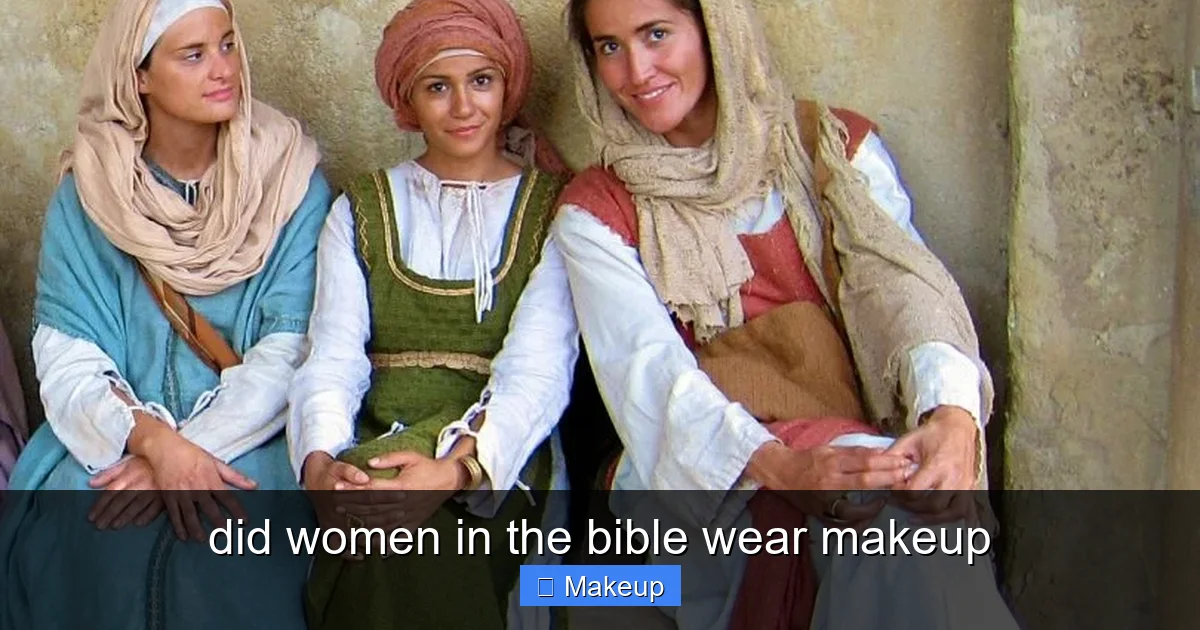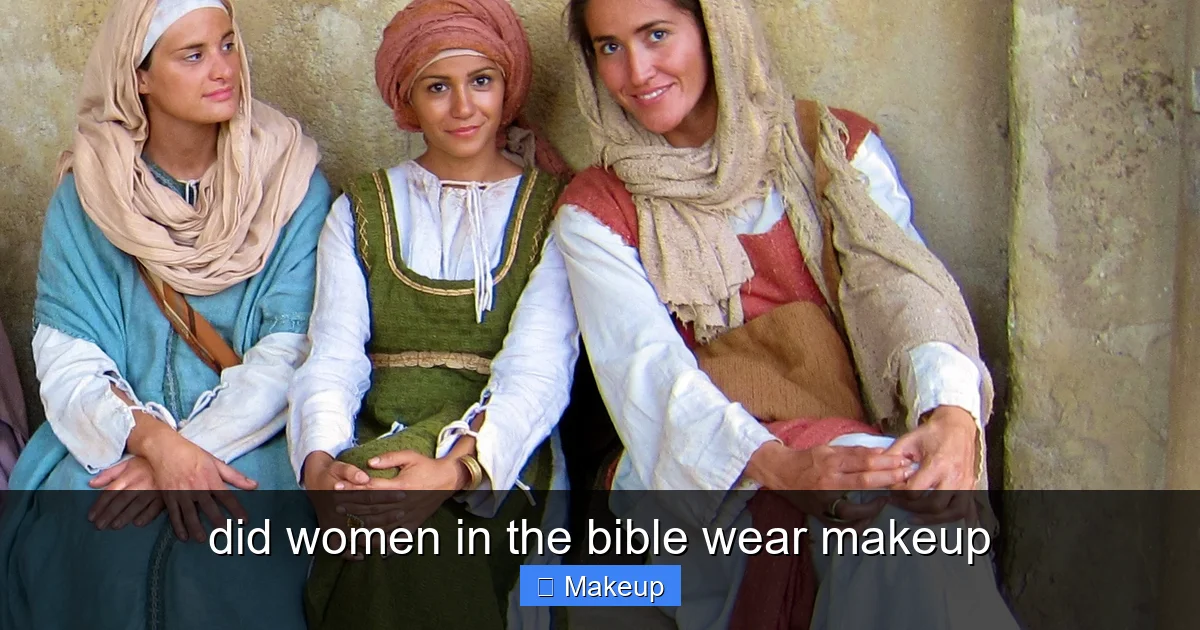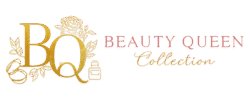
Featured image for this comprehensive guide about did women in the bible wear makeup
Image source: kgebamerica.com
The quest for beauty is as old as humanity itself. From intricate hairstyles to elaborate garments, people across cultures and millennia have sought to enhance their appearance. But what about the earliest documented societies, particularly those found within the pages of the Bible? A question often pondered is: did women in the Bible wear makeup?
The answer, perhaps surprisingly to some, is a resounding yes. While the Bible primarily focuses on spiritual and moral lessons, it occasionally offers glimpses into the daily lives, customs, and beauty practices of its characters. These references, though sometimes subtle and often metaphorical, confirm that ancient women, including those in biblical lands, were familiar with and utilized various forms of cosmetics. Let’s peel back the layers of history to explore this fascinating aspect of biblical life.
📋 Table of Contents
- Ancient Cosmetics: A Universal Practice Beyond the Bible
- Direct Mentions: Where the Bible Speaks of Makeup
- What Kind of “Makeup” Did They Use?
- The Symbolism and Context of Makeup in Biblical Times
- Beyond the Brush: Holistic Ancient Beauty Practices
- Modern Interpretations and Lessons from Ancient Beauty
Ancient Cosmetics: A Universal Practice Beyond the Bible
Before delving into specific biblical accounts, it’s crucial to understand the broader context of ancient beauty practices. Long before the biblical era, civilizations across the globe were already sophisticated in their use of cosmetics.
Beauty Across Civilizations
Archaeological evidence from ancient Egypt, Mesopotamia, and the Indus Valley shows extensive use of makeup dating back thousands of years. Egyptians famously used kohl to line their eyes, not just for beauty but also to protect against the harsh desert sun and ward off evil spirits. They also used malachite for green eyeshadow, red ochre for lips and cheeks, and henna for dyeing nails and hair. In Mesopotamia, similar practices were observed, with the rich and powerful adorning themselves with elaborate makeup and perfumes made from oils and resins.
| Biblical Passage / Figure | Beauty Practice / Product Mentioned | Contextual Interpretation / Purpose |
|---|---|---|
| Jezebel (2 Kings 9:30) | “Painted her eyes” (likely kohl/antimony) | Associated with wickedness, defiance, and harlotry; often cited as a negative example of adornment. |
| Jeremiah 4:30; Ezekiel 23:40 | “Paint your eyes,” “decorate yourself with ornaments” | Used metaphorically to describe a nation’s idolatry and unfaithfulness, portraying a seductive yet unholy display. |
| Esther 2:12 | Six months with oil of myrrh, six months with perfumes and cosmetics | Part of an elaborate, year-long royal beautification process for potential queens, seen as a legitimate preparation for status. |
| Song of Solomon (various) | Myrrh, frankincense, henna, perfumes, spices | Descriptions of natural beauty enhanced by aromatic substances, celebrated in a romantic and positive context. |
| Ancient Near East Culture (General) | Kohl (for eyes), ochre (for lips/cheeks), perfumed oils | Common practice across cultures for aesthetic appeal, social status, and sometimes practical purposes (e.g., kohl protecting eyes). Not inherently moral or immoral. |
The Raw Materials of Ancient Beauty
The ingredients for these ancient cosmetics were sourced directly from nature. Minerals like galena (lead sulfide) for black kohl, malachite (copper carbonate) for green eye paint, and various iron oxides (ochres) for reds and yellows were ground into fine powders. Plants provided dyes like henna, while fragrant resins and oils from trees and flowers were used for perfumes and skin conditioners. The sophistication of these practices suggests that personal adornment was not a frivolous pastime but an integral part of culture, identity, and social expression.
Direct Mentions: Where the Bible Speaks of Makeup
While the Bible doesn’t offer a beauty manual, it does contain specific instances and metaphorical references that clearly indicate the use of cosmetics. These references provide direct answers to the question: did women in the Bible wear makeup?

Learn more about did women in the bible wear makeup – did women in the bible wear makeup
Image source: get.pxhere.com
Jezebel: The Most Famous Instance
Perhaps the most explicit and well-known biblical mention of makeup involves Queen Jezebel, the infamous wife of King Ahab. In 2 Kings 9:30, it is written: “When Jehu came to Jezreel, Jezebel heard of it; and she painted her eyes and adorned her head and looked out of the window.” The Hebrew word used for “painted her eyes” is “puk,” which specifically refers to the application of kohl or antimony to darken and outline the eyes. This passage clearly shows a woman using makeup, even in a context of defiance and preparation for a dramatic confrontation.
Prophetic Warnings and Metaphors
Beyond Jezebel, several prophetic books use the imagery of makeup and adornment, often in a negative context, to symbolize idolatry or a nation’s unfaithfulness. These passages, however, indirectly confirm the common practice of wearing makeup:
- Jeremiah 4:30: “And you, O desolate one, what do you mean that you dress in scarlet, that you adorn yourself with ornaments of gold, that you enlarge your eyes with paint (puk)? In vain you beautify yourself. Your lovers despise you; they seek your life.” Here, Jeremiah uses the act of “enlarging eyes with paint” as a metaphor for Jerusalem’s futile attempts to attract allies, highlighting a common beauty practice.
- Ezekiel 23:40: Describing the unfaithful sisters Oholah and Oholibah (representing Samaria and Jerusalem), Ezekiel says: “Indeed, they sent for men to come from afar, to whom a messenger was sent; and there they came. And you washed yourself for them, painted your eyes (puk), and adorned yourself with ornaments.” This again links eye paint with the act of preparing oneself for allure, albeit in a condemned context.
These prophetic warnings do not condemn makeup itself but rather the vanity, deception, or idolatrous motivations associated with its use in those specific allegories. They strongly indicate that women in the Bible did wear makeup as a known and recognizable part of their beauty routines.
The Song of Solomon: Implied Adornment
While the Song of Solomon doesn’t explicitly mention makeup, its lavish descriptions of beauty – “your eyes are doves,” “your lips are like a scarlet thread,” “your cheeks are like a bed of spices” – suggest a culture where physical attractiveness was appreciated and enhanced. While these could be natural attributes, the emphasis on detailed features often implies careful attention and adornment, potentially including subtle cosmetic enhancements.
What Kind of “Makeup” Did They Use?
Given the biblical mentions and archaeological evidence, we can piece together a picture of the types of cosmetics available to and used by ancient women. This sheds more light on the question of did women in the Bible wear makeup and what that makeup entailed.

Learn more about did women in the bible wear makeup – did women in the bible wear makeup
Image source: biblejournalingdigitally.com
Here’s a look at common ancient cosmetics and their applications:
- Kohl (Antimony): This was the most prevalent eye makeup. Made from ground minerals like galena (lead sulfide) or antimony, it was applied with a small stick to darken eyelids and lashes, creating a bold, almond-shaped eye. It served both cosmetic and protective purposes, thought to ward off eye diseases and reduce sun glare.
- Red Ochre & Other Pigments: Natural iron oxides, yielding red and yellow pigments, were used to color lips and cheeks. These could be mixed with oils or fats to create a paste, providing a blush or lip stain.
- Henna: Derived from the henna plant, this natural dye was used for centuries to color hair, nails, and skin. It could create reddish-brown hues and was often used for intricate patterns on hands and feet for celebrations.
- Fragrances and Oils: While not “makeup” in the modern sense, perfumed oils were essential for skin care, hair conditioning, and overall body fragrance. They were often made from olive oil infused with frankincense, myrrh, spikenard, or other aromatic plants. These were crucial for personal grooming and often considered a significant part of a woman’s attractiveness.
These ancient beauty aids were not as diverse or synthetic as modern cosmetics but were effective and deeply rooted in the natural resources available.
The Symbolism and Context of Makeup in Biblical Times
The use of cosmetics in biblical times carried various meanings, reflecting social status, cultural norms, and personal intentions. Understanding this context helps us further analyze if and did women in the Bible wear makeup, and why.
Status and Wealth
Elaborate makeup and perfumes were often symbols of wealth and social standing. The ingredients could be costly, requiring trade and specialized preparation. Only the affluent could afford the finest kohl, rare perfumes, and the time for intricate beauty rituals. Therefore, makeup could signify a woman’s position in society.
Allure and Seduction
As seen in the prophetic books, makeup was often associated with attracting attention, sometimes in a negative or seductive light. This isn’t to say all makeup use was condemned, but rather that its use in specific contexts could imply vanity, deceit, or immorality, especially when coupled with other extravagant adornments. The Bible often contrasts outward show with inward purity and humility.
Preparation for Special Occasions
Just as today, makeup was likely applied for significant events such as weddings, feasts, or meeting important guests. It was part of preparing one’s best appearance for public presentation or celebratory gatherings. The act of “adorning” oneself often implied a full preparation, including cosmetics.
Cultural Norms vs. Divine Favor
While makeup was a cultural norm, biblical teachings often prioritized inner beauty, righteousness, and a gentle spirit over outward adornment (e.g., 1 Peter 3:3-4, 1 Timothy 2:9-10). This doesn’t mean makeup was inherently sinful, but rather that its pursuit should not overshadow spiritual virtues. The Bible’s emphasis is consistently on the heart, regardless of outward appearance.
Beyond the Brush: Holistic Ancient Beauty Practices
Answering the question, did women in the Bible wear makeup, gives us a piece of the puzzle, but ancient beauty was a more holistic endeavor, encompassing much more than just cosmetics.
Hygiene and Skincare
Cleanliness was paramount. Regular bathing, often with perfumed waters, and the application of oils (like olive oil) to moisturize skin were common. These practices were essential for maintaining health and a pleasant appearance in arid climates.
Hair Styling and Adornment
Hair was a significant aspect of beauty. Women would braid their hair, often adorning it with ribbons, jewels, or headbands. Long, well-kept hair was admired and sometimes used to express marital status or piety.
Clothing and Jewelry
Elaborate garments and jewelry were integral to a woman’s overall presentation. Rich fabrics, vibrant dyes, and precious metals for necklaces, earrings, and bracelets completed the look, often signifying wealth and status alongside makeup.
Modern Interpretations and Lessons from Ancient Beauty
The historical evidence confirms that did women in the Bible wear makeup, and they did so with a degree of sophistication. What lessons can we glean from these ancient practices today?
Timeless Desire for Enhancement
The desire to enhance one’s appearance is a universal and timeless human trait. From biblical times to the present, people have sought ways to feel more confident and attractive. This enduring aspiration connects us across millennia.
Inner vs. Outer Beauty: A Persistent Theme
The biblical emphasis on inner beauty over outward adornment remains a powerful message. While cosmetics can be a tool for self-expression and confidence, the Bible consistently reminds us that true worth and lasting beauty emanate from character, kindness, and spiritual well-being.
Practical Takeaways: Embracing Natural Ingredients
The reliance on natural ingredients in ancient cosmetics offers inspiration for modern beauty trends. The interest in natural, organic, and plant-based products today echoes the practices of biblical times, encouraging us to consider the source and purity of what we apply to our skin.
So, did women in the Bible wear makeup? Absolutely. From Jezebel’s defiant kohl-lined eyes to the metaphorical allusions in prophetic books, the scriptures, alongside archaeological findings, paint a clear picture of ancient women using various cosmetics. This practice was not always celebrated and sometimes carried symbolic weight concerning vanity or unfaithfulness, but it was undoubtedly a part of their world.
Ultimately, the story of makeup in the Bible reminds us that while external adornment has always been a part of human culture, the timeless wisdom of the scriptures continually points us toward cultivating an inner beauty that far surpasses any fleeting cosmetic enhancement. It’s a balance that continues to resonate with us today, encouraging us to appreciate beauty in all its forms, both inward and outward.
🎥 Related Video: Should CHRISTIAN WOMEN wear MAKEUP & JEWELRY?
📺 DLM Christian Lifestyle
In this video, Daniel answers the question ‘Should Christian women wear makeup & jewelry?’ What does the Bible say about …
Frequently Asked Questions
Did women in the Bible wear makeup?
Yes, there are indeed references in the Bible that suggest women in ancient times, particularly within certain cultural contexts, did use cosmetics. This practice was not exclusive to the Israelites but was a common aspect of beauty and adornment in many ancient Near Eastern cultures.
Are there specific biblical passages that mention women wearing makeup?
The Bible contains several passages that directly or indirectly allude to women wearing makeup. For instance, Ezekiel 23:40 describes women painting their eyes, and Jeremiah 4:30 speaks of a woman adorning herself with paint. These references often appear in prophetic critiques, confirming the existence of such beauty practices.
Was wearing makeup considered good or bad in the Bible?
The Bible does not issue a blanket condemnation against wearing makeup. However, it often associates excessive or deceptive use of cosmetics with vanity, seduction, or a misplaced focus on outward appearance over inner virtue. The emphasis is typically on the heart’s condition and genuine beauty rather than external adornment itself.
What types of makeup did women in the Bible use?
Ancient women commonly used kohl, a dark powder made from antimony or galena, to outline and darken their eyelids and eyelashes, creating a distinctive almond shape. They also employed various dyes for hair coloring, along with fragrant oils and perfumes which were crucial for both hygiene and personal beautification.
Did all women in the Bible wear makeup, or was it limited to certain groups?
It’s unlikely that all women universally wore makeup, as its usage probably varied significantly based on social status, wealth, and geographical location. While passages might highlight elite women or those in specific roles (like prostitutes) using cosmetics, it was likely also a common practice for many women seeking personal beautification, especially in urban centers.
Does the Bible offer a modern perspective on wearing makeup for Christian women today?
While the Bible doesn’t explicitly forbid makeup, its overarching message for Christian women emphasizes inner beauty, modesty, and a spirit that doesn’t rely on outward adornment for self-worth. Today, the principles encourage using makeup in a way that honors God, reflects a modest character, and avoids vanity or drawing undue attention to oneself.
